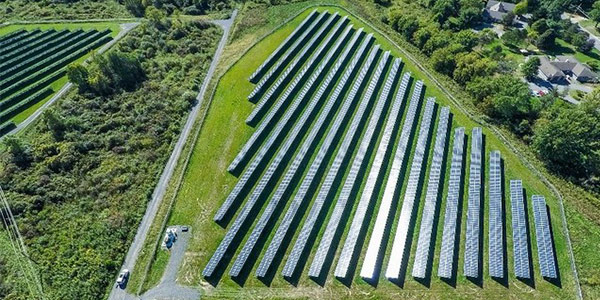By Michael Kuser
New York officials, utilities and solar energy advocates are trading comments through the state’s Public Service Commission on what constitutes appropriate compensation for the capacity value of distributed energy resources (VDER) (Case 15-E-0751; 15-E-0082).
The comments come after the PSC in December issued a staff white paper regarding capacity value compensation and in January ruled that John F. Kennedy International Airport could have a solar project up to 5 MW compensated under the VDER program while having other solar projects dedicated to serving on-site load (Case 18-E-0766). (See NYPSC Clarifies Value Stack Capacity Limits.)
In the value stack white paper, Department of Public Service staff recommend replacing the market transition credit (MTC) model, a value based on installed capacity estimates, with a new “community credit” model to compensate participants of community distributed generation (CDG) projects.
The commission’s original VDER order in March 2017 directed that the state’s compensation scheme for eligible DER transition from net energy metering (NEM) to the value stack, which bases compensation on provided benefits. The PSC’s Jan. 17 declaratory ruling said, “The rated capacity of projects used solely for serving on-site load and not seeking compensation under the value stack or net metering should not be counted towards the rated capacity limit.”
Rate Design
The DPS’ Utility Intervention Unit (UIU) filed comments that addressed rate designs for post-NEM mass market customers — those with eligible on-site generation.
“The proposed rate relies in part on advanced metering infrastructure (AMI) capability, which New York utilities have not yet fully implemented,” the UIU said. “Thus, to the extent that AMI is required to participate in this rate, the proposal appears premature.”
The Clean Energy Parties (CEP) — an ad hoc group including the Solar Energy Industries Association, Coalition for Community Solar Access, Pace Energy and Climate Center, Natural Resources Defense Council, New York Solar Energy Industries Association and Vote Solar — filed comments supporting DPS staff’s recognition “that some aspects of the tariff, such as DRV [demand reduction value], were achieving a false sense of accuracy and recommends changes that will better align the financial signals sent to customers with the benefits they can provide to the distribution system.”
The group said that for more than a year they have “made the case that the current tariff does not accurately reflect the value of distributed energy resources or provide stable enough compensation.” The state’s utilities show “a surprising misunderstanding of the development process for medium-sized to larger-sized solar energy facilities,” it said.
Utilities — including Central Hudson Gas & Electric, Consolidated Edison, New York State Electric and Gas, Niagara Mohawk Power, Orange and Rockland Utilities, and Rochester Gas and Electric — dismissed New York City’s advocacy of a higher MTC for Con Ed as unnecessary.
In addition to the 18 MW of projects identified in Tranche 0/1 as of March 1, 2019, Con Ed’s interconnection queue contains an additional 84.7 MW of eligible projects, including 42.5 MW of fuel cell projects, the utilities said. Because fuel cells are expected to operate at capacity factors in excess of 90% and achieve a high coincidence with the DRV, they will have the same cost impact as roughly 255 MW of solar installations, they said.
Resource Eligibility
The PSC last September expanded the eligibility of DER to be compensated under the state’s value stack tariffs, particularly standalone storage systems with 5 MW or less of capacity, including crediting to any clean generation technology that qualifies as a Tier 1 resource under the Clean Energy Standard (CES).
The new rules also make resources eligible for compensation that would qualify for Tier 1 but for their start date before Jan. 1, 2015, and also authorize interzonal crediting, allowing DERs receiving value stack compensation to apply credits to the bills of customers in the same utility territory but different NYISO load zones. (See NYPSC Takes Subway into Value Stack.)
In responding to the white paper, the utilities suggested that, rather than exposing customers to long-term commitments that provide limited customer benefits, DRV compensation should be tied to DER production during each utility’s service territory-specific peak hours.
“To the extent that the current 10-peak-hour window creates more volatility than is deemed necessary to support development of eligible resources, a modest expansion to 50 hours may be appropriate,” the utilities said. “Similarly, the [state’s] Office of General Services argues that behind-the-meter generation should also be eligible for value stack compensation. This proposal should be rejected as customers using generation to offset their usage are already avoiding distribution and energy charges.”
The utilities opposed creating a community credit, but if one is established, they also oppose the recommendation by large commercial and industrial end-users that its costs be allocated only to residential customers, favoring instead the same methodology as the MTC, which allocates costs to those customer classes that receive the benefit.
They also recommended that the PSC reject the CEP’s suggestion to establish a Distribution Planning Advisory Committee, saying that “such a committee is unnecessary and would duplicate the existing Distributed System Implementation Plan Advisory Committee” and also create an additional burden on stakeholder resources.



